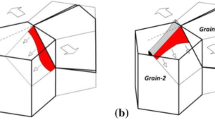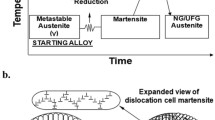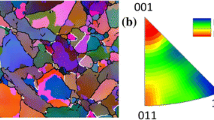Abstract
This work underscores the effect of local microstructural configuration on the dislocation movement and micro-mechanical behaviour in fine/ultra-fine-grained (< 2 μm), cold-rolled, and annealed 301L austenitic stainless steel by site-specific nanoindentation experiments. Indentation loading, holding, and unloading behaviour have been studied separately for five different microstructural categories. Hardness and modulus vary proportionally from one indentation to another. It has been observed that a large density of high-angle boundaries most competently restricts the dislocation motion (strain hardening) resulting in high hardness. However, the back stress generated by the dislocation pile-up aids recovery during holding/unloading. Contrarily, the coarse grain reveals lower hardness attributed to easy dislocation transmission and a lesser elastic recovery during holding/unloading owing to an insufficient back stress in the absence of a favourable dislocation pile-up. The observation is against the general expectation considering the grain size dependence of the formation of pile-ups in ductile materials subjected to large-scale deformation. Interestingly, low-angle boundaries interact more with the dislocations and form such a defect structure that the strain locally reaches the critical value for the formation of deformation-induced martensite following Kurdjumov–Sachs orientation relationship with the parent austenite.
Graphical abstract











Similar content being viewed by others
References
Jiang M, Devincre B, Monnet G (2019) Effects of the grain size and shape on the flow stress: a dislocation dynamics study. Int J Plast 113:111–124. https://doi.org/10.1016/j.ijplas.2018.09.008
Berbenni S, Favier V, Berveiller M (2007) Impact of the grain size distribution on the yield stress of heterogeneous materials. Int J Plast 23:114–142. https://doi.org/10.1016/j.ijplas.2006.03.004
Johnston TL, Feltner CE (1970) Grain size effects in the strain hardening of polycrystals. Metall Mater Trans 1:1161–1167. https://doi.org/10.1007/BF02900226
El-Danaf E, Kalidindi SR, Doherty RD (1999) Influence of grain size and stacking-fault energy on deformation twinning in fcc metals. Metall Mater Trans A 30:1223–1233. https://doi.org/10.1007/s11661-999-0272-9
Gracio JJ (1994) The double effect of grain size on the work hardening behaviour of polycrystalline copper. Scr Metall Mater 31:487–489. https://doi.org/10.1016/0956-716X(94)90024-8
Kang S, Jung JG, Kang M et al (2016) The effects of grain size on yielding, strain hardening, and mechanical twinning in Fe–18Mn–0.6C–1.5Al twinning-induced plasticity steel. Mater Sci Eng A 652:212–220. https://doi.org/10.1016/j.msea.2015.11.096
Mao KS, Sun C, Shiau CH et al (2020) Role of cavities on deformation-induced martensitic transformation pathways in a laser-welded, neutron irradiated austenitic stainless steel. Scr Mater 178:1–6. https://doi.org/10.1016/j.scriptamat.2019.10.037
Krupp U, West C, Christ H-J (2008) Deformation-induced martensite formation during cyclic deformation of metastable austenitic steel: influence of temperature and carbon content. Mater Sci Eng A 481–482:713–717. https://doi.org/10.1016/j.msea.2006.12.211
Conrad H (2003) Grain size dependence of the plastic deformation kinetics in Cu. Mater Sci Eng A 341:216–228. https://doi.org/10.1016/S0921-5093(02)00238-1
Wang N, Wang Z, Aust KT, Erb U (1995) Effect of grain size on mechanical properties of nanocrystalline materials. Acta Metall Mater 43:519–528. https://doi.org/10.1016/0956-7151(94)00253-E
Karimzadeh A, Koloor SS, Ayatollahi MR et al (2019) Assessment of Nano-Indentation Method in Mechanical Characterization of Heterogeneous Nanocomposite Materials Using Experimental and Computational Approaches. Sci Rep 9:1–14. https://doi.org/10.1038/s41598-019-51904-4
Fischer-Cripps AC (2004) Nanoindentation. Mechanical Engineering Series. Appl Mech Rev 57(2):B12. https://doi.org/10.1115/1.1704625
Liu M, Lu C, Tieu KA et al (2015) A combined experimental-numerical approach for determining mechanical properties of aluminum subjects to nanoindentation. Sci Rep 5:1–16. https://doi.org/10.1038/srep15072
Sabooni S, Karimzadeh F, Enayati MH, Ngan AHW (2015) The role of martensitic transformation on bimodal grain structure in ultrafine grained AISI 304L stainless steel. Mater Sci Eng A 636:221–230. https://doi.org/10.1016/j.msea.2015.03.101
Lee W-S, Lin C-F (2000) The morphologies and characteristics of impact-induced martensite in 304L stainless steel. Scr Mater 43:777–782. https://doi.org/10.1016/S1359-6462(00)00487-5
Kisko A, Hamada AS, Talonen J et al (2016) Effects of reversion and recrystallization on microstructure and mechanical properties of Nb-alloyed low-Ni high-Mn austenitic stainless steels. Mater Sci Eng A 657:359–370. https://doi.org/10.1016/j.msea.2016.01.093
Johnson KL (1985) Contact mechanics, 1st edn. Cambridge University Press
He BB, Huang MX, Liang ZY et al (2013) Nanoindentation investigation on the mechanical stability of individual austenite grains in a medium-Mn transformation-induced plasticity steel. Scr Mater 69:215–218. https://doi.org/10.1016/j.scriptamat.2013.03.030
Pöhl F (2019) Pop-in behavior and elastic-to-plastic transition of polycrystalline pure iron during sharp nanoindentation. Sci Rep 9:1–12. https://doi.org/10.1038/s41598-019-51644-5
He BB, Liang ZY, Huang MX (2018) Nanoindentation investigation on the initiation of yield point phenomenon in a medium Mn steel. Scr Mater 150:134–138. https://doi.org/10.1016/j.scriptamat.2018.03.015
Misra RDK, Zhang Z, Jia Z et al (2011) Nanomechanical insights into the deformation behavior of austenitic alloys with different stacking fault energies and austenitic stability. Mater Sci Eng A 528:6958–6963. https://doi.org/10.1016/j.msea.2011.05.068
Qiao X, Han L, Zhang W, Gu J (2015) Nano-indentation investigation on the mechanical stability of individual austenite in high-carbon steel. Mater Charact 110:86–93. https://doi.org/10.1016/j.matchar.2015.10.024
Sekido K, Ohmura T, Sawaguchi T et al (2011) Nanoindentation/atomic force microscopy analyses of ε-martensitic transformation and shape memory effect in Fe–28Mn–6Si–5Cr alloy. Scr Mater 65:942–945. https://doi.org/10.1016/j.scriptamat.2011.08.010
Durst K, Backes B, Franke O, Göken M (2006) Indentation size effect in metallic materials: modeling strength from pop-in to macroscopic hardness using geometrically necessary dislocations. Acta Mater 54:2547–2555. https://doi.org/10.1016/j.actamat.2006.01.036
Lorenz D, Zeckzer A, Hilpert U et al (2003) Pop-in effect as homogeneous nucleation of dislocations during nanoindentation. Phys Rev B Condens Matter Mater Phys 67:1–4. https://doi.org/10.1103/PhysRevB.67.172101
Shuang F, Xiao P, Bai Y (2020) Efficient and reliable nanoindentation simulation by dislocation loop erasing method. Acta Mech Solida Sin 33:586–599. https://doi.org/10.1007/s10338-020-00175-y
Ruestes CJ, Alhafez IA, Urbassek HM (2017) Atomistic studies of nanoindentation—A review of recent advances. Curr Comput-Aided Drug Des 7:1–15. https://doi.org/10.3390/cryst7100293
Jiao S, Tu W, Zhang P et al (2018) Atomistic insights into the prismatic dislocation loop on Al (1 0 0) during nanoindentation investigated by molecular dynamics. Comput Mater Sci 143:384–390. https://doi.org/10.1016/j.commatsci.2017.11.031
Tsuru T, Shibutani Y (2007) Anisotropic effects in elastic and incipient plastic deformation under (001), (110), and (111) nanoindentation of Al and Cu. Phys Rev B Condens Matter Mater Phys 75:1–6. https://doi.org/10.1103/PhysRevB.75.035415
Li J, Van Vliet KJ, Zhu T et al (2002) Atomistic mechanisms governing elastic limit and incipient plasticity in crystals. Nature 418:307–310. https://doi.org/10.1038/nature00865
Zhou N, Elkhodary KI, Huang X et al (2020) Dislocation structure and dynamics govern pop-in modes of nanoindentation on single-crystal metals. Philos Mag 100:1585–1606. https://doi.org/10.1080/14786435.2020.1739348
Soer WA, Aifantis KE, De Hosson JTM (2005) Incipient plasticity during nanoindentation at grain boundaries in body-centered cubic metals. Acta Mater 53:4665–4676. https://doi.org/10.1016/j.actamat.2005.07.001
Fang Q, Chen Y, Li J et al (2019) Probing the phase transformation and dislocation evolution in dual-phase high-entropy alloys. Int J Plast 114:161–173. https://doi.org/10.1016/j.ijplas.2018.10.014
Mandal A, Morankar S, Sen M et al (2020) A descriptive model on the grain size dependence of deformation and martensitic transformation in austenitic stainless steel. Metall Mater Trans A 51:3886–3905. https://doi.org/10.1007/s11661-020-05861-7
Van Tol RT (2014) Microstructural evolution in deformed austenitic twinning induced plasticity steels. Delft University of Technology. https://doi.org/10.4233/uuid:b2a057e2-c545-4bcc-854c-fe4b9344e486
Oliver WC, Pharr GM (1992) An improved technique for determining hardness and elastic modulus using load and displacement sensing indentation experiments. J Mater Res 7:1564–1583. https://doi.org/10.1557/JMR.1992.1564
Yan FK, Zhang BB, Wang HT et al (2016) Nanoindentation characterization of nano-twinned grains in an austenitic stainless steel. Scr Mater 112:19–22. https://doi.org/10.1016/j.scriptamat.2015.08.034
Molkeri A, Pahlevani F, Emmanuelawati I, Sahajwalla V (2016) Thermal and mechanical stability of retained austenite in high carbon steel: an in-situ investigation. Mater Lett 163:209–213. https://doi.org/10.1016/j.matlet.2015.10.083
Chen T, Tan L, Lu Z, Xu H (2017) The effect of grain orientation on nanoindentation behavior of model austenitic alloy Fe-20Cr-25Ni. Acta Mater 138:83–91. https://doi.org/10.1016/j.actamat.2017.07.028
Besharatloo H, Carpio M, Cabrera JM et al (2020) Novel mechanical characterization of austenite and ferrite phases within duplex stainless steel. Metals 10:1–15. https://doi.org/10.3390/met10101352
Schwarm SC, Kolli RP, Aydogan E et al (2017) Characterization of phase properties and deformation in ferritic-austenitic duplex stainless steels by nanoindentation and finite element method. Mater Sci Eng A 680:359–367. https://doi.org/10.1016/j.msea.2016.10.116
Goldman AJ, Robertson WD (1964) Elastic properties of austenite and martensite in iron-nickel alloys. Acta Metall 12:1265–1275. https://doi.org/10.1016/0001-6160(64)90111-7
Li P, Karaca HE, Chumlyakov YI (2017) Orientation dependent compression behavior of Co35Ni35Al30 single crystals. J Alloys Compd 718:326–334. https://doi.org/10.1016/j.jallcom.2017.04.307
Wo PC, Ngan AHW (2004) Investigation of slip transmission behavior across grain boundaries in polycrystalline Ni3Al using nanoindentation. J Mater Res 19:189–201. https://doi.org/10.1557/jmr.2004.19.1.189
Hedström P (2005) Deformation induced martensitic transformation of metastable stainless steel AISI 301. Luleå University of Technology. https://www.diva-portal.org/smash/get/diva2:998904/FULLTEXT01.pdf
Petch NJ (1953) The cleavage strength of polycrystals. J Iron Steel Inst 174:25–28
Armstrong RW (1968) Theory of the tensile ductile-brittle behavior of poly-crystalline h.c.p. materials, with application to beryllium. Acta Metall 16:347–355. https://doi.org/10.1016/0001-6160(68)90021-7
Chen Z, Cai H, Zhang X et al (2006) Analysis for twinning and slip in face-centered cubic crystals under axisymmetric co-deformation. Sci China Ser E Technol Sci 49:521–536. https://doi.org/10.1007/s11431-006-2016-z
Wilkinson AJ (2001) Modelling the effects of texture on the statistics of stage I fatigue crack growth. Philos Mag A 81:841–855. https://doi.org/10.1080/01418610108214323
Sakharova NA, Fernandes JV, Antunes JM, Oliveira MC (2009) Comparison between Berkovich, Vickers and conical indentation tests: a three-dimensional numerical simulation study. Int J Solids Struct 46:1095–1104. https://doi.org/10.1016/j.ijsolstr.2008.10.032
Sapezanskaia I, Roa JJ, Fargas G et al (2017) Deformation mechanisms induced by nanoindentation tests on a metastable austenitic stainless steel: a FIB/SIM investigation. Mater Charact 131:253–260. https://doi.org/10.1016/j.matchar.2017.07.019
Li J, Fang Q, Liu B, Liu Y (2018) Transformation induced softening and plasticity in high entropy alloys. Acta Mater 147:35–41. https://doi.org/10.1016/j.actamat.2018.01.002
Sargent PM, Ashby MF (1992) Indentation creep. Mater Sci Technol 8:594–601. https://doi.org/10.1179/mst.1992.8.7.594
Li WB, Warren R (1993) A model for nano-indentation creep. Acta Metall Mater 41:3065–3069. https://doi.org/10.1016/0956-7151(93)90119-D
Li WB, Henshall JL, Hooper RM, Easterling KE (1991) The mechanisms of indentation creep. Acta Metall Mater 39:3099–3110. https://doi.org/10.1016/0956-7151(91)90043-Z
Xu ZH, Ågren J (2004) An analysis of piling-up or sinking-in behaviour of elastic-plastic materials under a sharp indentation. Philos Mag 84:2367–2380. https://doi.org/10.1080/14786430410001690015
Lu S, Zhang B, Li X et al (2019) Grain boundary effect on nanoindentation: a multiscale discrete dislocation dynamics model. J Mech Phys Solids 126:117–135. https://doi.org/10.1016/j.jmps.2019.02.003
Cao Y, Wang YB, An XH et al (2014) Concurrent microstructural evolution of ferrite and austenite in a duplex stainless steel processed by high-pressure torsion. Acta Mater 63:16–29. https://doi.org/10.1016/j.actamat.2013.09.030
He BB, Huang MX (2014) Revealing the intrinsic nanohardness of lath martensite in low carbon steel. Metall Mater Trans A Phys Metall Mater Sci 46:688–694. https://doi.org/10.1007/s11661-014-2681-7
Acknowledgements
The authors gratefully acknowledge the Department of MME and CRF, IIT Kharagpur, particularly the instrumented micro-nano-indentation facility developed under the SGDRI-2015 Institute grant, and AFMM, IISc Bangalore, for the experimental facilities.
Author information
Authors and Affiliations
Corresponding author
Ethics declarations
Conflict of interest
The authors declare that they have no known competing financial interests or personal relationships that could have influenced the work reported in this paper.
Additional information
Handling Editor: Megumi Kawasaki.
Publisher's Note
Springer Nature remains neutral with regard to jurisdictional claims in published maps and institutional affiliations.
Supplementary Information
Below is the link to the electronic supplementary material.
Rights and permissions
About this article
Cite this article
Mandal, A., Modak, P., Sen, M. et al. Influence of local microstructure on the dislocation transference and micro-mechanical response in metastable fcc alloy. J Mater Sci 57, 1390–1402 (2022). https://doi.org/10.1007/s10853-021-06605-7
Received:
Accepted:
Published:
Issue Date:
DOI: https://doi.org/10.1007/s10853-021-06605-7




